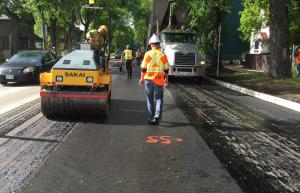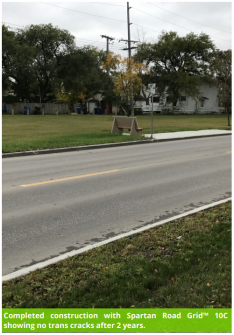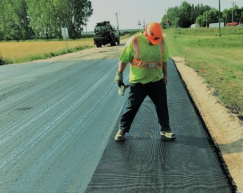Author: Matthew Bradford

Innovation is underfoot in Canada’s road building sector. At job sites across the country, geosynthetic materials are being used in greater frequency to provide contractors with a stronger, more sustainable, and cost-efficient base for their projects.
“Geosynthetics aren’t new to the industry, but they’re always evolving,” says Sam Bhat, Vice President of Global Business Development & Chief Technical Officer, Geosynthetics with Titan Environmental Containment (Titan). “This isn’t a concept – but a solution that’s proven to deliver significant long-term benefits when combined with the right design and installation.”
With decades of experience in geosynthetic material development, Bhat has watched the material be adapted for applications in various fields (e.g. mining, oil & gas, and civil infrastructure construction, etc.). Alongside the team at Titan, he has also helped clients arrive at geosynthetic system designs and strategies that work best for their specific works.
“These are smart solutions that reduce work, increase the lifespan of pavements, and dramatically minimize the carbon footprint, but only if done properly and tailored to the specific site conditions. And that’s where we come in,” Bhat says.
Among these innovations is the Spartan Road Grid™, which has been applied on several infrastructure projects. A recent example includes the geogrid’s application on an asphalt road repaving project at Gateway and Concordia Street within the City of Winnipeg. Here, crews faced the challenge of rehabilitating pavement with significant path fatigue cracking due in part to poor performing asphalt overlay. And while milling and applying a new inlay or an overlay would offer a short-term fix, the City recognized this would do little to enhance the road’s overall performance or longevity.

Enter: Titan, which proposed placing Spartan Road Grid™ between the asphalt base and top layer to reinforce the overlay/inlay and increase the strength and stiffness of the asphalt, all while requiring fewer resources and leaving little impact on the environment.
“The conventional solution would have been to mill the road to a certain depth and apply asphalt of the same thickness. Our solution, however, required 30% less asphalt to do so, saving time, resources, and costs while also minimizing the carbon footprint,” says Sam, adding, “There are many long-term benefits. By applying the geogrid, the aim is to minimize reflective cracking, extend the life of the pavement, and greatly reduce maintenance costs.”
The advantages of Spartan Road Grid™ also surfaced out West, where Spartan Road Grid™ polymer-coated fiberglass grids and fiberglass geogrid–geotextile composites were used on several road rehabilitation projects in Calgary, Alberta. Here again, Titan collaborated with local crews to design and install a geogrid system that resulted in less milling and overlay/inlay requirements while also contributing to each surface’s longevity.

A road near Calgary’s airport proved especially challenging for the team. When Titan arrived on site, it had deteriorated to the point that crews thought new construction was the only option. Here again, Bhat suggested an easier and more cost-effective solution.
“After consulting with our design engineer, we went back to them with a solution that didn’t require digging everything up and starting again. With a custom geogrid installation, we could do a less demanding reconstruction,” Bhat explains.
The plan, he continued, was to perform a partial reconstruction that included excavating slightly below the asphalt, placing its swamp grid, and then compacting it with granular material. Next, asphalt layer was placed to bring the path to road level.
“We drove on that road years later. I was in the passenger seat with my eyes closed and trust me when I say I couldn’t feel a bump or crack along the way,” Bhat recalls.
Setting a foundation
Geosynthetic materials have proved their worth on (and below) surfaces across Canada. And as Sam says, these case studies in Calgary and Winnipeg serve as proof that these engineered materials can withstand whatever Canada throws their way: “These projects demonstrate how geogrids hold up in severe winters or freeze/thaw cycles, so our clients have confidence that it will work for them.”
Here again, he adds, “We have this amazing material that contributes positively to the environment, but the important thing to remember is that maximum benefit can be derived when the right product is selected along with custom-designed and correctly installed to suit the site-specific conditions.
These are only some road-building projects showcasing the utility, flexibility, and strength of Spartan Road Grid™. Look out for our next profile of Titan’s geogrid products and visit Titan Environmental Containment for more solutions.

